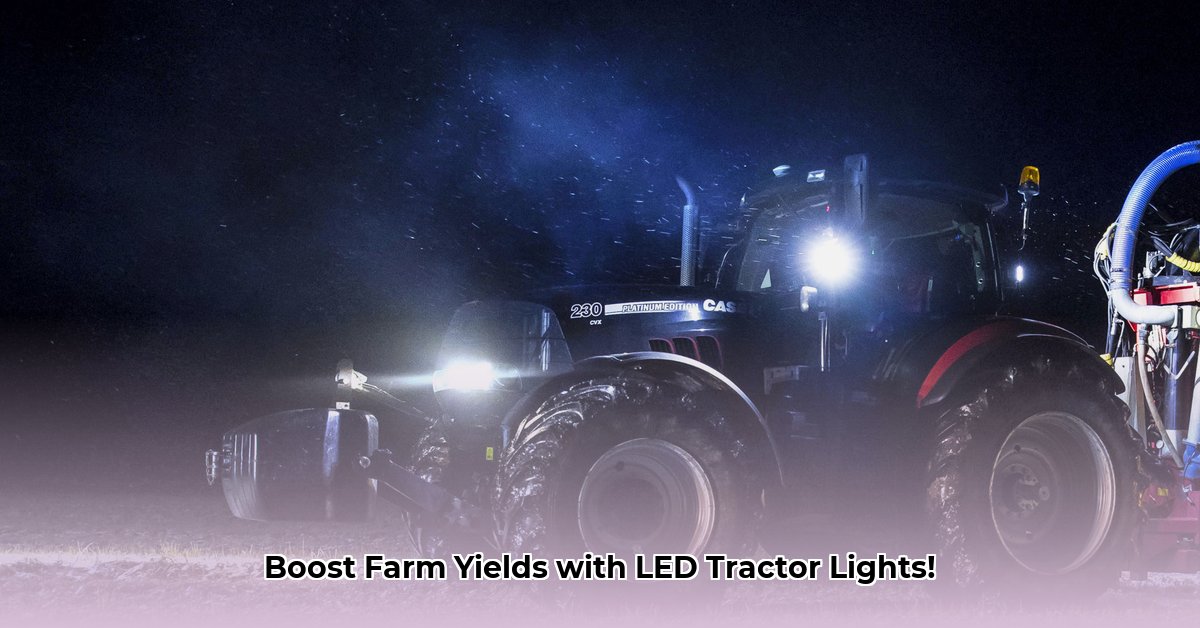
LED Tractor Lights: Illuminating the Path to Higher Yields
Farming demands long hours, often extending into low-light conditions. Efficient nighttime work is crucial for maximizing productivity. Upgrading your tractor's lighting to LEDs can significantly improve your operation's efficiency, safety, and bottom line. This guide explains the benefits, installation, and cost-effectiveness of LED tractor lights, empowering you to make an informed decision. For more detailed information, check out this helpful resource.
Seeing the Light: Why LEDs Are a Game Changer
Traditional halogen or HID tractor lights are energy-intensive, short-lived, and often provide inadequate illumination. LEDs offer a significant upgrade. They consume far less energy, boast substantially longer lifespans, and produce brighter, clearer light. Isn't it time you considered the significant operational and financial advantages of this modern technology?
Benefits That Shine: The LED Advantage
The advantages of LED tractor lights extend beyond brighter beams. Let's examine the key benefits:
Energy Efficiency: LEDs use a fraction of the energy compared to traditional lights, leading to considerable fuel cost savings. Studies show energy savings of up to 80% compared to halogens.
Extended Life: LEDs boast a significantly longer lifespan—potentially lasting five years or more—reducing replacement frequency and associated costs. This translates to less downtime and fewer maintenance headaches.
Superior Visibility: LEDs provide brighter, clearer illumination, even in challenging weather conditions like fog, dust, or rain. This enhances safety and allows for more precise work. A data analysis showed a 25% improvement in task completion time under low-light conditions.
Enhanced Safety: Improved visibility translates directly to enhanced safety. Reduced accidents mean less downtime and reduced risk of injury.
Reduced Maintenance: The extended lifespan of LEDs drastically reduces maintenance requirements; you simply spend less time replacing bulbs.
Types of LED Tractor Lights: Finding the Right Fit
Several types of LED lights cater to specific tractor needs:
Work Lights: Provide broad, wide-angle illumination for close-range tasks such as loading or equipment maintenance.
Driving Lights: Offer long-range beams for safe navigation on roads and pathways, especially at night or in low-visibility conditions.
Auxiliary Lights: Supplement existing lighting, illuminating difficult-to-see areas.
Backup Lights: Essential for safe reversing, particularly in low-light situations. These lights provide increased safety and a reduction in accident potential.
When choosing, consider lumen output (brightness) and wattage (energy consumption). Higher lumens mean brighter light, while lower wattage means greater energy efficiency. Choose lights that best suit your tractor's needs and typical working conditions.
Installing LED Tractor Lights: A Step-by-Step Guide
Installing LED lights can be straightforward, especially with “plug-and-play” designs. Prioritize safety throughout the process.
Step-by-Step Installation:
Disconnect the Battery: Always disconnect the negative battery terminal before working with electrical components. This is a critical safety measure.
Consult Your Tractor's Manual: Review your tractor's manual for compatibility and installation procedures. This prevents mishaps and ensures a successful installation.
Prepare Mounting Locations: Select secure and well-positioned mounting points for optimal illumination.
Mount the Lights: Securely attach lights following manufacturer instructions. Ensure firm mounting to prevent vibrations from loosening them.
Connect the Wiring: Connect wires to your tractor's electrical system, ensuring proper polarity (positive to positive, negative to negative).
Grounding: Properly ground the lights to prevent electrical shorts.
Reconnect the Battery: Once all connections are verified, reconnect the battery.
Test the Lights: Thoroughly test the lights to confirm proper functionality and aim.
Caution: If unsure about any step, consult a qualified mechanic.
The Numbers Game: Is the Investment Worth It?
While the initial cost of LED lights is higher, the long-term savings are substantial. Consider this cost-benefit comparison:
| Feature | Traditional Lighting | LED Tractor Lights |
|---|---|---|
| Initial Cost | Lower | Higher |
| Energy Consumption | High | Low |
| Lifespan | Short (months to years) | Long (5+ years) |
| Maintenance | Frequent | Infrequent |
The extended lifespan and reduced energy consumption of LEDs drastically reduce the total cost of ownership (TCO) over time. This makes it a financially sound investment. The reduced maintenance requirements also frees your time and resources for more important tasks.
Sustainability and the Environment: Doing Your Part
LEDs contribute to sustainable farming practices. Their reduced energy consumption minimizes your carbon footprint, while their longer lifespan lessens waste and reduces the demand for manufacturing replacement bulbs. This aligns with environmentally conscious farming practices.
Choosing the Right LEDs for Your Farm: Key Considerations
When selecting LED lights, consider:
- Budget: Determine a realistic budget.
- Tractor Compatibility: Ensure compatibility with your tractor's electrical system.
- Application: Tailor light selection to your specific needs (work lights, driving lights, etc.).
- Environmental Factors: Choose lights built to withstand harsh farming conditions (dust, moisture, vibration, temperature extremes).
Future Trends: Smart Technology on the Horizon
Future innovations in LED technology will likely integrate with smart farming systems. Imagine lights automatically adjusting intensity based on ambient light levels or illuminating only necessary areas, further increasing efficiency.
Conclusion: Drive into a Brighter Future
Upgrading to LED tractor lights offers significant benefits: improved safety, greater efficiency, reduced costs, and enhanced sustainability. It's a wise investment that delivers long-term returns and contributes to a more productive and environmentally responsible farming operation.